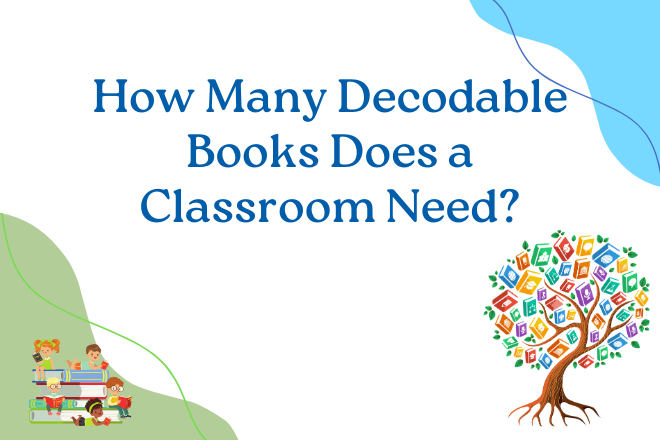How Many Decodable Books Does a Classroom Need?
The number of decodable books needed for a classroom can vary based on several factors, including the grade level, the curriculum being used, and the specific needs of the students. However, it's common for classrooms to have a set of decodable books that align with the phonics and reading skills being taught at a particular grade level.
Here are some factors to consider when deciding how many decodable books your classroom needs.
Variety of Phonics Patterns
Phonics instruction typically follows a structured scope and sequence, gradually introducing students to increasingly complex letter-sound relationships and spelling patterns. Your selection of decodable books should reflect this progression, offering students opportunities to encounter and practice decoding various types of words.
For instance, early decodable texts might focus on simple consonant-vowel-consonant (CVC) words, such as "cat" or "dog," which are foundational for developing basic decoding skills. As students advance, they can explore more intricate patterns, including consonant blends (e.g., "bl," "dr," "sn"), vowel digraphs (e.g., "ai," "oa," "ee"), and diphthongs (e.g., "ou," "ow," "oi"). Additionally, exposure to common prefixes and suffixes, as well as irregular spellings and sight words, further enriches students' decoding abilities.
Ultimately, a well-rounded collection of decodable books serves as a valuable resource for supporting students' phonics development and fostering their overall literacy proficiency.
Progression of Difficulty
Organizing decodable books in a progressive manner is important for scaffolding students’ learning and ensuring their steady advancement in phonics proficiency. A structured progression of difficulty facilitates a systematic approach to skill development, enabling students to consolidate their understanding of foundational concepts before tackling more complex phonics patterns.
As students navigate increasingly complex texts, they develop essential decoding strategies and linguistic awareness, laying a solid foundation for proficient reading comprehension and literacy achievement. Ultimately, a well-designed progression of difficulty in decodable books optimizes students' learning experiences and fosters a lifelong love of reading.
Differentiated Instruction
It's beneficial to have a range of decodable books that cater to different reading levels. This supports differentiated instruction, allowing teachers to provide materials that match the individual needs of their students.
At the core of differentiated instruction is the recognition that students possess varying levels of proficiency and require personalized support to maximize their learning potential. For instance, struggling readers may benefit from decodable books with simplified text and repetitive structures, enabling them to focus on mastering fundamental phonics skills without feeling overwhelmed. On the other hand, advanced readers can be challenged with decodable texts featuring more complex phonics patterns and vocabulary, allowing them to expand their decoding abilities and comprehension skills.
Class Size
Class size is a crucial factor to consider when determining the quantity of decodable books needed for a classroom. The number of books required directly correlates with the total number of students in the class and influences how resources are allocated to support effective instruction.
In larger classrooms with a greater number of students, it becomes imperative to ensure equitable access to decodable books for all learners. This necessitates having multiple copies of each book available to accommodate the diverse reading needs and preferences of students. By providing sufficient copies, educators can facilitate whole-class instruction, small-group activities, and independent reading sessions without logistical constraints or interruptions.
Moreover, the size of the classroom impacts the frequency and duration of reading sessions, as well as the distribution of instructional materials. In a larger class, educators may need to implement strategic scheduling and rotation systems to optimize the use of available resources and maximize student engagement. Additionally, having ample copies of decodable books enables teachers to implement differentiated instruction effectively, tailoring reading materials to meet the individual needs and interests of students across varying proficiency levels.
Budget Constraints
Budget constraints present a significant challenge when it comes to procuring decodable books for classroom use. In many educational settings, funding limitations necessitate careful planning and strategic decision-making to ensure that essential resources are allocated effectively to support student learning.
When faced with budget constraints, educators and school administrators must prioritize the acquisition of decodable books based on their instructional value and alignment with curriculum objectives. This may involve conducting thorough needs assessments to identify the most pressing literacy needs and selecting decodable books that address those priorities. Additionally, considering the longevity and versatility of decodable books can help maximize the impact of limited resources over time.
Furthermore, educators may explore alternative sources of funding, such as grants, donations, or fundraising initiatives, to supplement budgetary allocations for purchasing decodable books. Collaborating with community organizations, parent-teacher associations, and local businesses can also provide opportunities to secure additional resources and support literacy initiatives in the classroom.
Availability of Digital Resources
Some educational publishers offer digital versions of decodable books, which can be accessed on devices. In such cases, the number of physical copies needed may be supplemented with digital access.
With digital access, educators can instantly provide students with a wide range of decodable texts without the need for physical copies. This is particularly beneficial in classrooms with limited storage space or budget constraints, where acquiring large quantities of print materials may not be feasible. Additionally, digital decodable books offer the flexibility to adjust font size, customize text-to-speech features, and incorporate interactive elements, catering to the diverse needs and preferences of students.
When determining the specific number of decodable books for a classroom, it's advisable to consult with the curriculum provider, follow any guidelines provided by the educational publisher, and consider the unique needs and characteristics of the students in the classroom. Additionally, teachers can assess the pace at which their students are progressing through the material and adjust the number of books accordingly.

